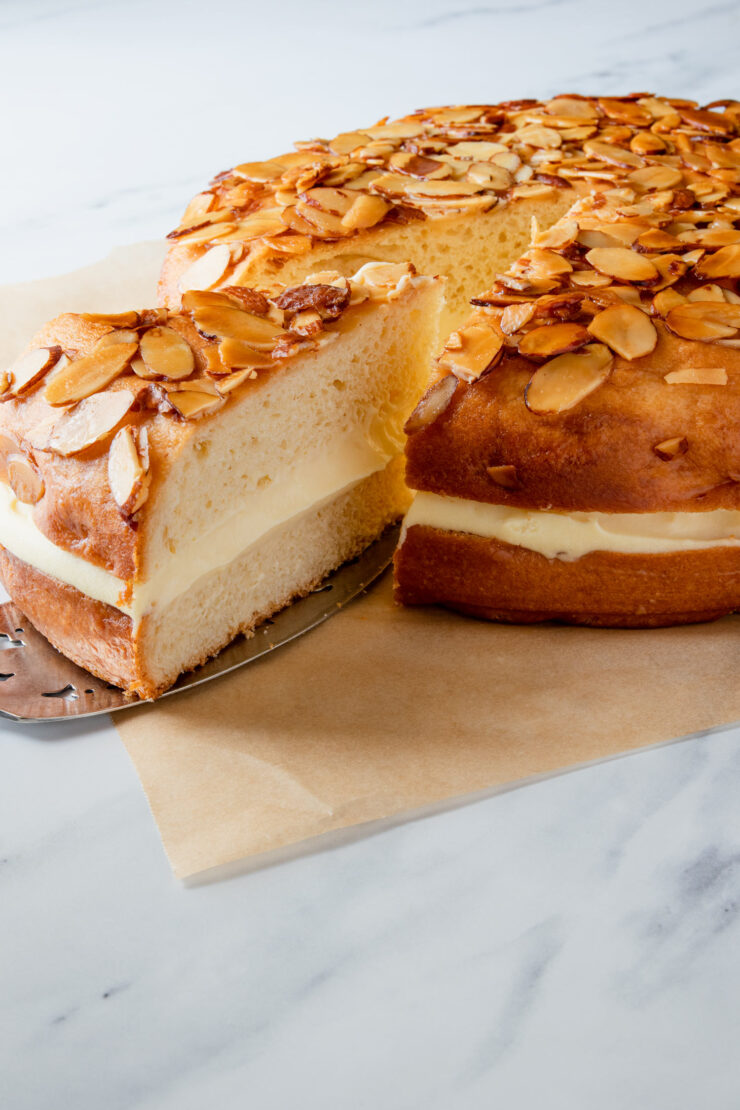
Bienenstich, or Bee Sting Cake, is a classic German dessert made of a sweet yeast dough filled with creamy vanilla custard and topped with caramelized almonds. Because it’s a yeast dough instead of cake, Bienenstich isn’t overly sweet. Instead, it’s a rich dessert that layers together several satisfying textures. Cracking through the honey almond topping reveals fluffy brioche layers sandwiching a silky pastry cream filling.

Bienenstich Origin
Bienenstich most likely originates from the Rhineland-Pfalz region of western Germany, and is also a popular dessert in Alsace. While its invention isn’t specifically known, there are two popular legends for the origin of Bienenstich.
The first credits the cake to Andernach in the Rhineland-Pfalz region of Germany. In the late 15th century, the Kaiser granted a toll on the Rhine to Andernach when it had previously been collected in Linz am Rhein. Linz am Rein was planning an attack on Andernach as retribution. On the morning before the battle, several apprentice bakers noticed bee nests by the city walls. They loosened the nests and hurled them at the attackers, who were stung and retreated to flee the swarm. The Andernach bakers invented Bienenstich, or bee sting cake, to celebrate.
Another legend claims that a baker testing new cake recipes was stung by a bee attracted to the honey almond topping. He decided to name the cake after the incident.
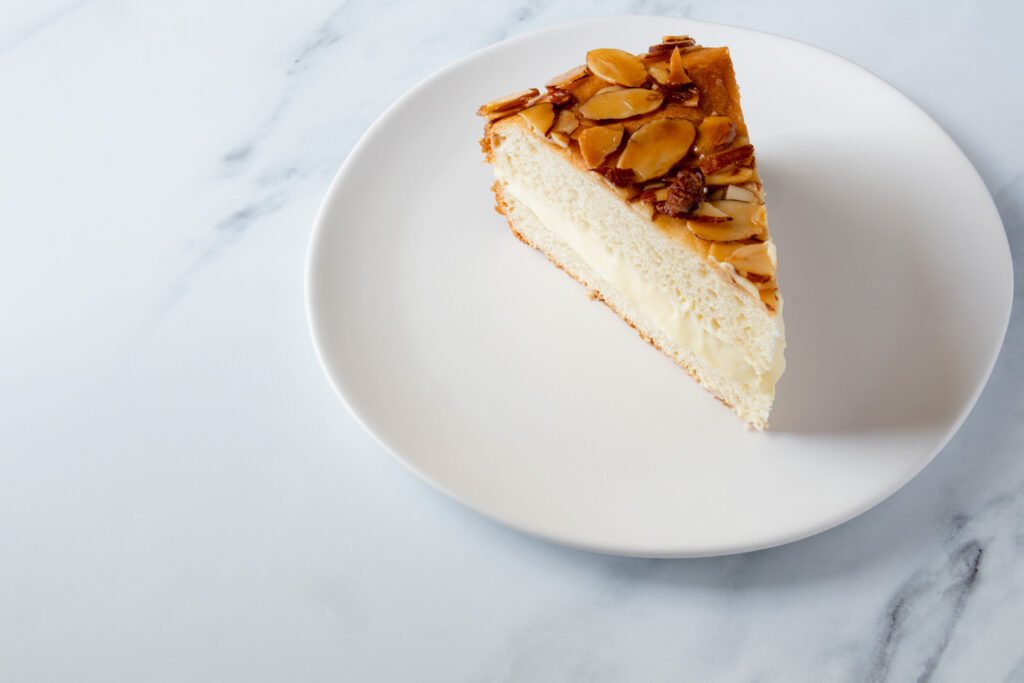
Tips for Making Bienenstich
- The base for this recipe is essentially a brioche dough. It’s very similar to the dough made for Kolaches, Brunsviger, or Coca de Sant Joan.
- Brioche is an enriched yeast dough. Enriched doughs are “richer” because they include sugar and fat, usually milk, butter or eggs. Fat shortens the gluten strands and increases its elasticity. This results in a bread with a more tender crumb and a soft crust. Adding sugar to yeast doughs gives more food to the yeast and speeds up fermentation. The extra sugar also produces a golden brown crust and a sweeter dough.
- The filling for this Bienenstich is similar to a diplomat cream. Vanilla pastry cream is lightened with whipped cream to make a silky filling.
- When making the pastry cream, gradually pour the hot milk into the egg yolk mixture and whisk constantly. By adding the milk slowly, you temper the eggs and prevent them from curdling.
- After the pastry cream starts to bubble, continue to cook it for another minute. This ensures the starch is fully cooked and the pastry cream won’t break down and loosen.
- While you can make the pastry cream the same day as long as you allow it to cool, I prefer to make it ahead to save time. The pastry cream can be made up to 3 days in advance and kept in the refrigerator.
- Keep a watchful eye on the heavy cream as you whip it. If it’s overwhipped, the milk solids may separate, essentially making sweetened butter.
- And now that you’ve made a wonderfully creamy and light diplomat cream, make sure the cake has cooled before you fill it. If the cake is warm, the beautiful filling you just made will melt.
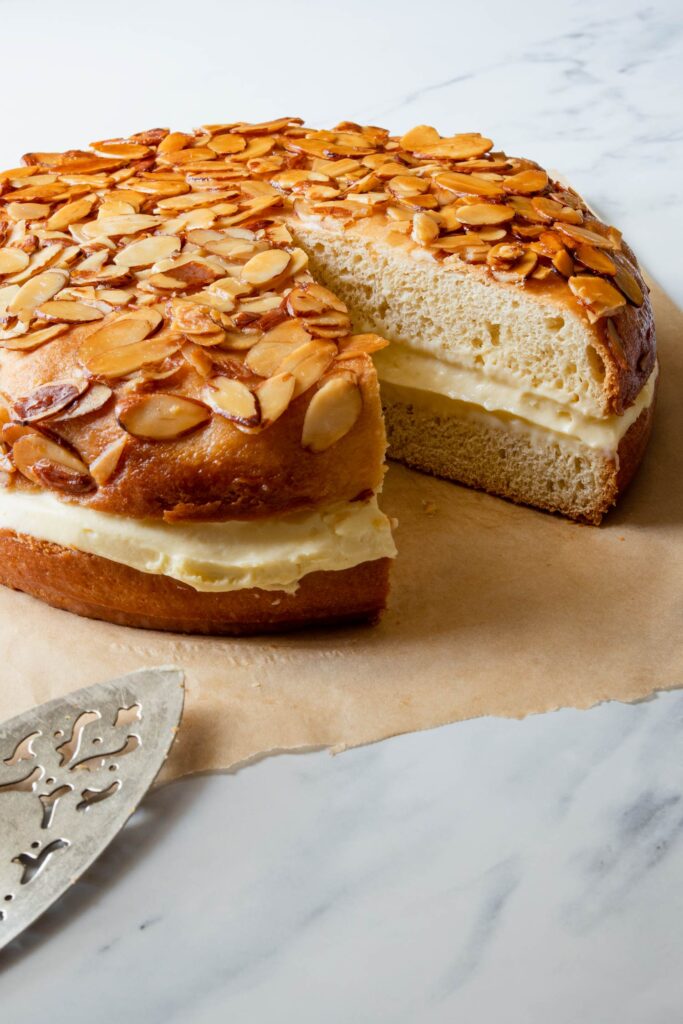
Ingredients:
Yields one 9-inch (24cm) cake
60ml whole milk, warmed to 46°C
7g active dry yeast (1 packet)
2 large eggs
25g sugar
1 tablespoon honey
1/4 teaspoon salt
280g plain flour
60g unsalted butter, softened to room temperature
FILLING
70g sugar
20g cornstarch
1/4 teaspoon salt
Yolks from 3 large eggs
360ml whole milk
1 teaspoon vanilla extract
120ml heavy cream
TOPPING
40g unsalted butter
40g honey
25g sugar
1 tablespoon heavy cream
85g sliced almonds
1/4 cup whole milk, warmed to 115°F
2 1/4 teaspoons active dry yeast (1 packet)
2 large eggs
2 tablespoons sugar
1 tablespoon honey
1/4 teaspoon salt
2 1/3 cups all-purpose flour
1/4 cup unsalted butter, softened to room temperature
FILLING
1/3 cup sugar
2 tablespoons cornstarch
1/4 teaspoon salt
Yolks from 3 large eggs
1 1/2 cups whole milk
1 teaspoon vanilla extract
1/2 cup heavy cream
TOPPING
3 tablespoons unsalted butter
2 tablespoons honey
2 tablespoons sugar
1 tablespoon heavy cream
3/4 cup sliced almonds
Make the Pastry Cream
1. Stir together sugar, cornstarch, salt:
Whisk together the sugar, cornstarch, and salt in a mixing bowl.
2. Whisk in the egg yolks:
Whisk in the egg yolks and mix until pale and smooth, about 1 minute.
3. Bring milk to a simmer:
Bring the milk to a simmer in a small saucepan over medium heat.
4. Add the milk to the yolk mixture:
When the milk comes to a simmer, remove it from the heat. Slowly pour the hot milk into the yolk mixture a splash at a time, whisking constantly.
5. Cook the pastry cream:
Transfer the mixture back into the saucepan and cook over medium heat until it begins to bubble. Then continue to cook for 1 more minute.
6. Whisk in the vanilla:
Remove the pastry cream from the heat. Stir in the vanilla extract.
7. Strain and chill:
Pour the pastry cream through a fine-mesh strainer into a bowl and cover with plastic wrap directly on the surface of the cream. Refrigerate until cool.
Make the Brioche Dough
1. Bloom the yeast:
In the bowl of a stand mixer fitted with a dough hook, mix the yeast and warm milk together and set aside while weighing the other ingredients. The yeast should start to foam after a few minutes, otherwise the yeast might be dead.
2. Mix the wet ingredients:
Add the eggs, sugar, honey, and salt to the milk. Set the mixer on medium for a few seconds to combine.
3. Add in the flour:
Pour in the flour and slowly work the mixer up to medium speed. Knead until everything combines, forming a dough.
4. Slowly add the butter:
With the mixer still running at medium speed, slowly add the butter, one bit at a time.
5. Knead the dough:
Knead the dough until it is smooth and elastic, approximately 6 minutes.

6. Let the dough rise:
Cover the bowl with plastic wrap or a damp tea towel and set in a warm place for 1 hour, or until the dough has doubled in size.

7. Grease the cake pan:
While the dough is rising, grease the pan. Butter the bottom and sides of a 9-inch (24cm) cake pan that is at least 2 inches (5cm) deep.
8. Shape the dough:
Gently shape the dough into a 9-inch (24cm) circle and place in the prepared cake pan.
Cover with plastic and let the dough rise for 30 minutes.
While the dough is rising, make the topping.
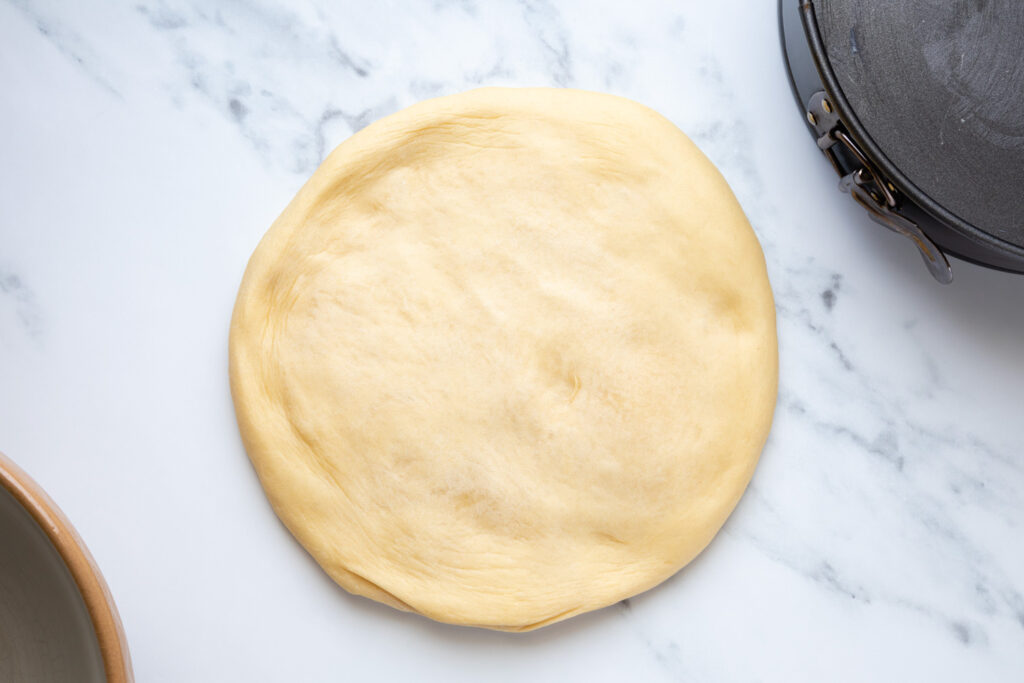
Make the Honey Almond Topping
1. Make the honey caramel:
Place the butter, honey, sugar, and cream in a small, heavy-bottomed saucepan. Set on medium high heat and bring to a boil. Cook for 2 to 3 minutes until it’s a light golden caramel color. Remove from the heat.
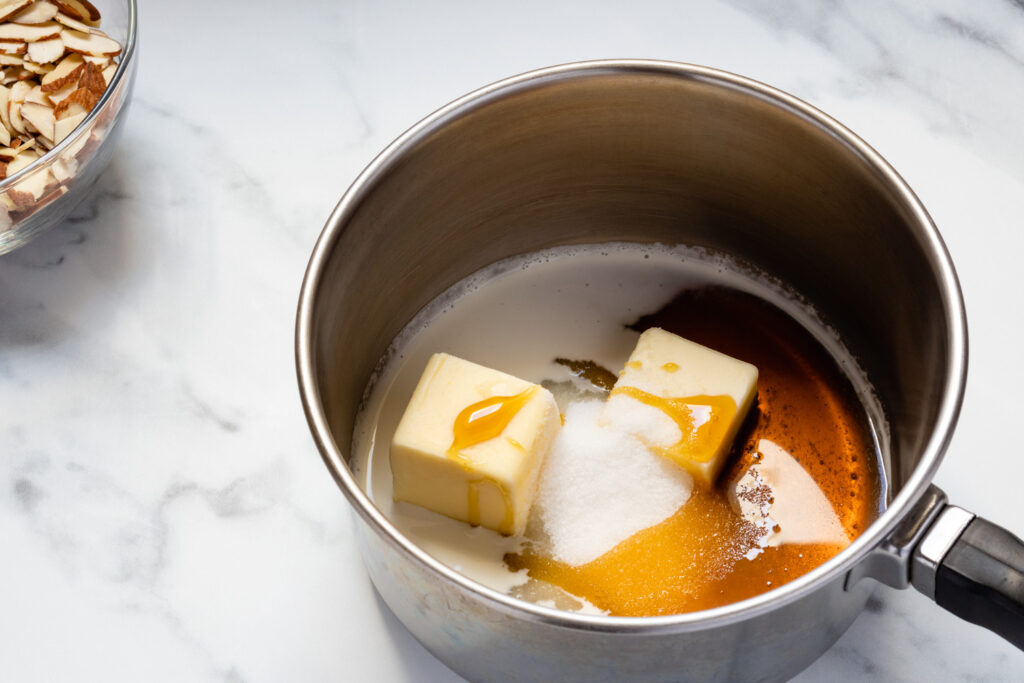

2. Add the almonds:
Stir in the almonds and let the caramel cool slightly while the dough continues rising.

Bake the Bienenstich
1. Preheat the oven:
Preheat the oven to 175°C (350°F).
2. Spread the topping over the dough:
Spread the honey almond topping evenly over the the brioche dough.
3. Bake the cake:
Bake the cake for 25 to 30 minutes, until the edges are golden and the topping is bubbling.
4. Cool:
Remove the cake from the oven and let it cool in the pan for 20 minutes to allow the topping to firm up.
Run a knife around the edges of the pan to loosen, then flip the cake out of the plan and place on a cooling rack so the almond topping is up.
Cool completely before filling.

Assemble the Bienenstich
1. Split the cake:
Split the cake in half horizontally with a serrated knife.
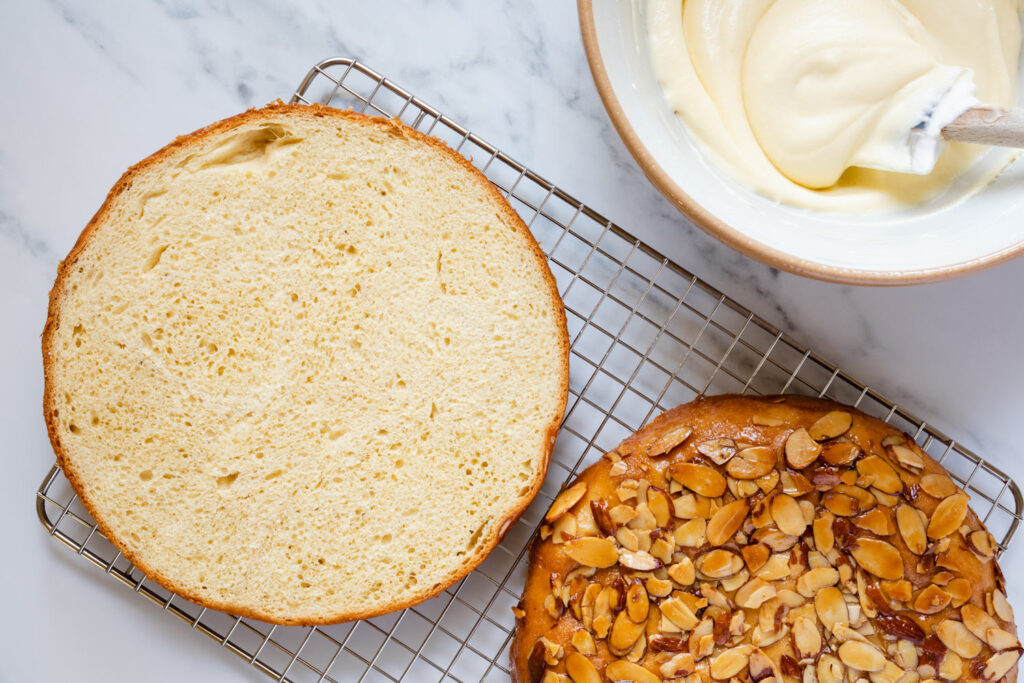
2. Finish the filling:
In the bowl of a stand mixer fitted with the whisk attachment, or in a large mixing bowl with a hand mixer, whip the cream until soft peaks form.
Remove the pastry cream from the refrigerator and remove the plastic. Whisk the pastry cream until smooth, about 1 minute.
Add the whipped cream to the pastry cream and use a rubber spatula to gently combine.
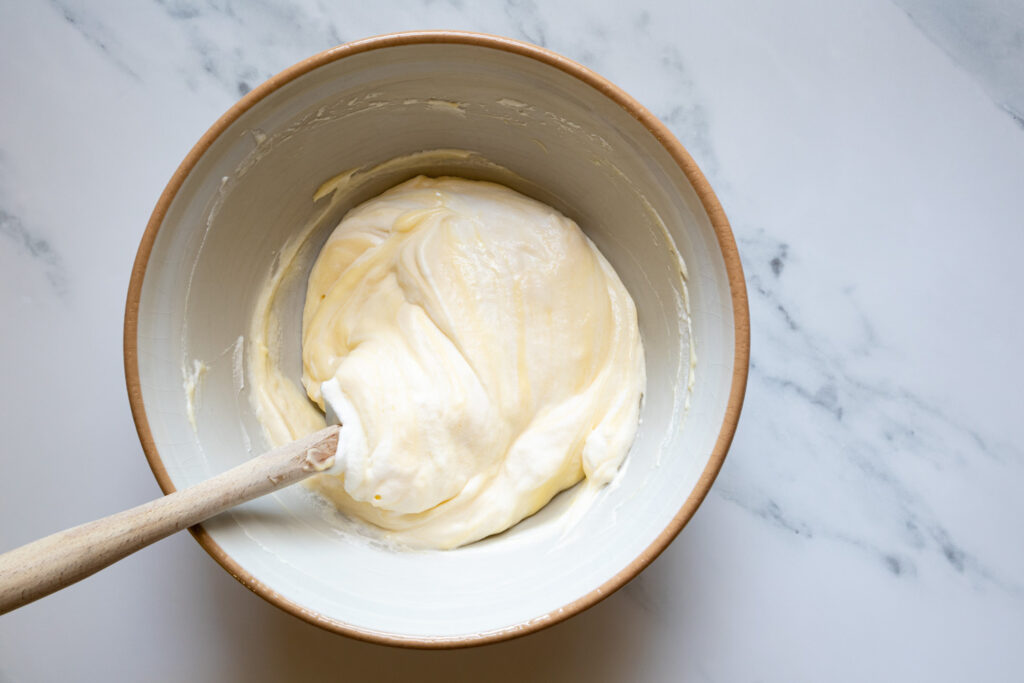
3. Fill the cake:
Place the bottom layer on a cake plate and spread with the filling. Place the top layer over the filling with the almond side up.
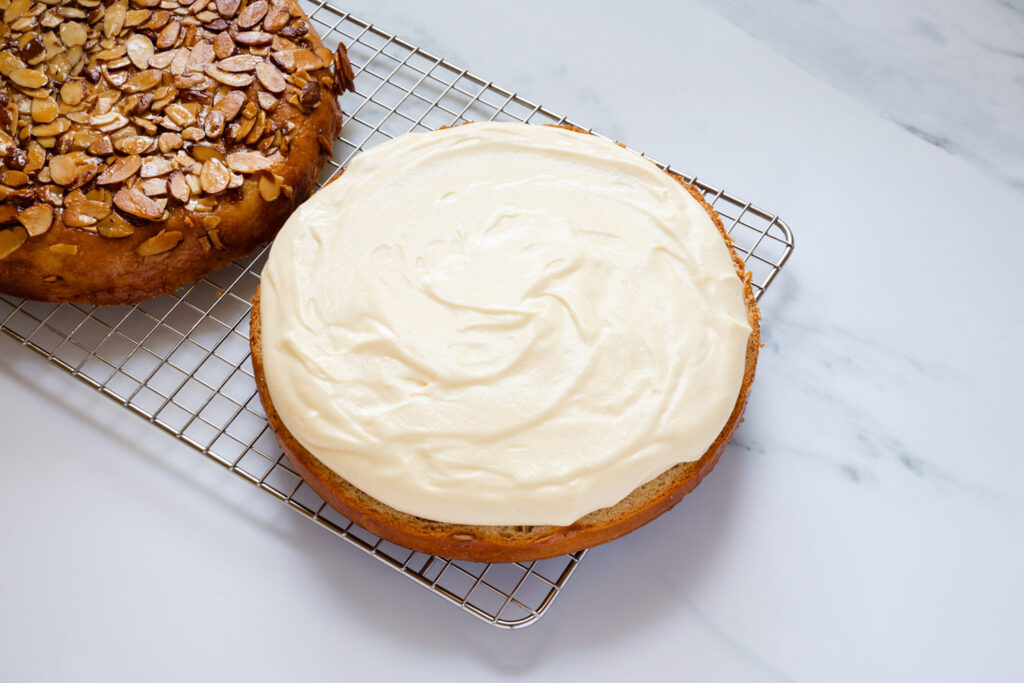
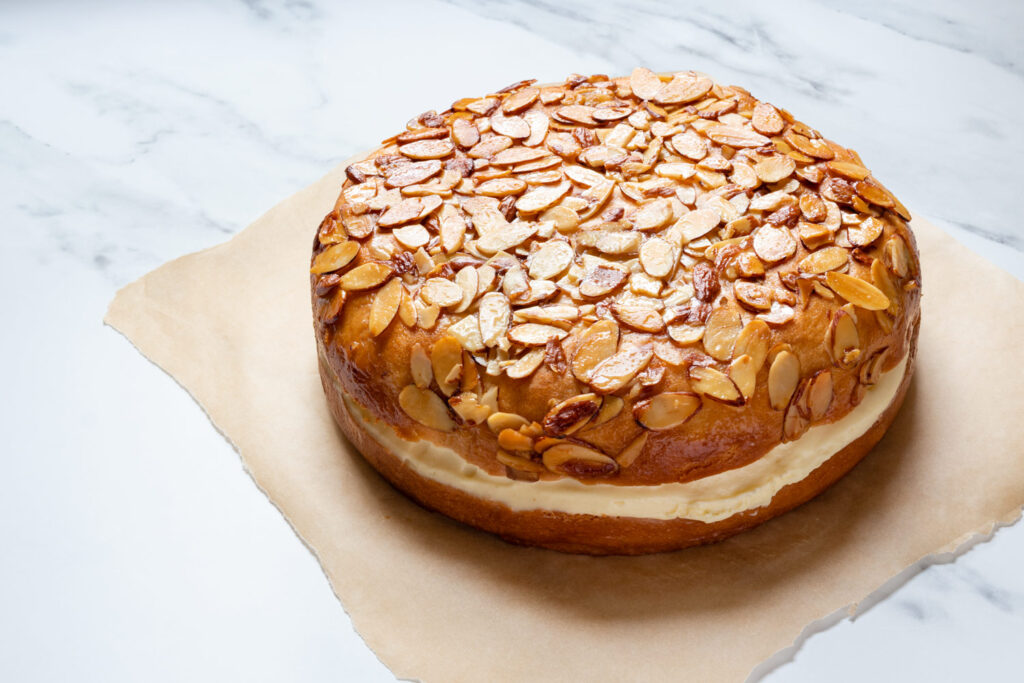

Bienenstich was my favorite treat from the local Konditorei when I was a young man living in Germany. Some of my ancestors came from the Rhineland-Pfalz area, but I was unaware of the colorful “bees-as-weapons” story. This will be a nice addition to our Easter table. Thank you for sharing this recipe!
I love learning about the history and legends behind recipes. I hope you enjoy your Easter dessert!
Seems odd the filling wouldn’t use honey and not sugar bee-ing the cake is honey forward.
Traditionally, the honey is in the almond topping. But a honey filling would be great too! I haven’t tried making pastry cream with honey, but I’m sure it can be done. Just be sure to adjust the amount, since honey is more concentrated than cane sugar.
Found this informative article on pastry cream https://www.seriouseats.com/vanilla-pastry-cream-creme-patissiere
Toward the bottom of the page is Adding Flavor to Pastry Cream. In essence it says the addition of additional egg yolks and cornstarch is proportional to the liquidity of whatever you are adding to the basic pastry cream recipe. The article is very interesting.
Thanks for sharing! You could try the recipe for honey pastry cream here: https://food52.com/recipes/62902-honey-long-johns/. And just like you said, they increased the egg yolks to account for the extra liquid from the honey